Sift, or Everything Around Her Was on Fire (detail)
While working on my new collection 'Darkling, I Listen', I have been reading a lot of Carl Jung and his interpretations on Alchemy and how this ancient process relates to his idea of individuation; the successful psychic process of 'becoming whole', or integrating the conscious with the unconscious ( or for me, in relation to 'Darkling', truly knowing & accepting oneself, despite the darkness, depression, melancholy or nightmares we may carry inside us. ) One of the stages of this process Jung likens to the alchemical stage of Nigredo, or the putrefaction, the blackening, the 'killing'. For Jung, this is the time one when meets their shadow and faces it. Not for banishment, but for acceptance. One must be destroyed in order to understand, in order to transcend.
Though these are not the foundations that artist Jessica Louise Dalva may have built her own new body of work, Hapax Legomena on, which opens on May 1st ( Happy Beltane!) at L.A.'s La Luz de Jesus Gallery, I still find threads of these ideas in the barren, ashen landscapes that appear to be the charred evidence of rolling fires, and in the solitude of the figures, perhaps just out of this fire themselves.
I like to think of Jessica working on these pieces, perhaps late at night. I think of the the intense, meticulous attention that must go into every choice, the literally molding & conjuring of flesh that holds no heartbeat, but yet still bears visceral emotions. I recently had the honor to ask Jessica some general questions about her process, as well as more ( self-serving perhaps!) personal ones about darkness and emotional solitude.
I like to think of Jessica working on these pieces, perhaps late at night. I think of the the intense, meticulous attention that must go into every choice, the literally molding & conjuring of flesh that holds no heartbeat, but yet still bears visceral emotions. I recently had the honor to ask Jessica some general questions about her process, as well as more ( self-serving perhaps!) personal ones about darkness and emotional solitude.
My mother is a ceramic sculptor and also used to make large hand-carved wooden sculptures, so I have always had sculpture around me. When I was little, I would make little cats and pinch pots on the porch with her while she worked on her pieces, which are primarily figurative or animal-based. In school, I majored in Illustration because I wanted to learn how to draw and paint, but I found myself frustrated and honestly sort of uninspired by painting- I wanted to play with more materials and spatial changes. I am always looking for new materials to use, and I really enjoy figuring out how to build something, and painting on a flat surface just sort of underwhelmed me.
Making a physical object from nothing (or from a lump of clay or scraps of fabric) is always very satisfying to me- it’s like taking flour, milk, butter and eggs; then magically you have a cake. Also, I feel that there is a certain charm and fascination that comes from wondering what something is made of or how it is constructed. That’s one of my favorite things about other artists’ work, the mystery of how it’s built, and sculpture offers a wide variety of problems to be solved with interesting and ever-changing techniques. I constantly feel like I might switch back entirely to painting and drawing, I do have a great love for both, and there is a very appealing flexibility there when all you need to make your art is a pencil and some paper. Part of me wants to paint giant oil paintings and draw messy portraits in charcoal, and perhaps I’ll have a chance to indulge that desire, but sculpture will always be a natural solution to me.
Over recent years, there has been a lot of cross over of what is considered ‘fine art’ and what is considered ‘craft.’ Could you talk about this blurring?
This is one of those never-ending debates- every “craftsperson” of worth will say that there is a degree of art to their work, and every honest “fine artist” would acknowledge the elements that are purely craft they use to create their art. I think that having infinite knowledge at our fingertips (aka the Internet) has been a significant influence in this blur- people are exposed to higher levels of skill from people that they would otherwise never interact with, so inspiration can come from a much wider source than it has in the past. You can see a master origami artist on the same page as a photorealistic painter and a textile sculptor, and it is more up to one’s own opinion whether any or all of these are artists or not. There is no singular Salon that is the end-all-be-all of artistic merit, as there has been before, and so we are freer from limitation on materials and techniques.
Can you talk about the process of working on a show, from conception to completion ?
The process is a long one! I’ve already got an inkling of what my next series will consist of. I generally start with many lists. Lists of words, colors, themes, phrases, titles, characters, animals, and even textures. Then I narrow things down to the main, important aspects, and decide a rough outline of pieces I want to make. This outline can morph considerably, and often. I then gather lots of reference and start sketching (though really, many of these steps cross back and forth for a few months- sketch and list and list and sketch). My sketches are sometimes very detailed, with measurements, material lists, and colors listed in the margins, but they can also be super loose and basically stick figures with a word or two to remind me what they are about.
Before, during, and after a show I have a number of lists running of ideas and elements to be included in this or future shows. The pieces all have a lot of different elements to them which require different tools, materials and processes, so sometimes I will assembly-line a task and get all the eyeballs painted glossy at once or make 15 different-sized armatures in an afternoon. As the pieces get more solidly finished, I lock down the titles, which I generally have a loose idea of while I work on the piece, but leave until the end so I am sure they really fit with the feeling of the completed piece.
Because I have limited studio space, I hang my pieces on my wall as they come into being, which is beneficial so I can see everything together and make sure there is a cohesive feel to the series. I also tend to try to rush together “one last thing” right before the show opens, as I never feel like I have enough done or have one more idea I just have to get done.
Helix
One of my greatest pleasures in life is drawing and sculpting from life- unfortunately it’s a luxury I cannot afford at this moment to indulge in on a regular basis or for every piece. I will occasionally hire a friend who is a lovely modern dancer to model for me and take reference photos of her, but the majority of my pieces’ poses are frankensteined reference from awkward photos of myself. If anyone ever got a hold of my Photo Booth images on my computer, they would be amused by a series of photos of me brandishing a broom in my underwear, or confused as to why on earth I needed to hold my arm up in the air for 27 minutely different hand gestures. I also will often take parts of a photo I find online or a sketch I’ve done from life and combine them in more refined sketches. I try to avoid directly using reference from the internet, though, as I don’t want to infringe on anyone’s work.
Also, as in a few previous works as well, the bodies of some of your figures are fissured, they become an ‘other' by these wounds that no ‘real’ person could survive. Can you talk about this hollowing, this violence?
There is an opportunity in sculpture (and all art, really) to create something that is at once fairly realistic and completely impossible. The feeling of hollowness or being torn apart is sort of a universally experienced phenomenon, even though, hopefully, most people don’t know what this would actually feel like. I also like to leave the source of these cavities open to suggestion, as we all have different experiences that leave us feeling this way. Maybe I often have leaned towards this symbolism because I am, in these instances, at a loss for another way to describe or illustrate how this feels. By representing an overwhelming and often seriously dangerous, destructive, feeling of despair with something that is unreal or unsurvivable, the gravity of its impact can really be seen.
Abyss
There seems to be a more visceral ‘darkness’ or melancholy in this body of work as a whole compared to other exhibitions. Many of the backgrounds are pared down, appear ashen or voids the figures are suspended in. Can you talk about this chosen landscape ?
Part of this theme is a personal desire to create work with a more graphic and simplified aesthetic, and part of it is because I had a pretty hard year, and drew a lot of inspiration from that. I wanted to focus on sculpting more realistic figures and animals, and I find that there was enough information in some of the pieces to capture my concept. I went through a variety of personal struggles that lead to many of the pieces, and much of this was centered around being alone and developing a more thoughtful relationship with myself. And also I hate painting backgrounds. :)
Sift, or Everything Around Her Was on Fire
Narrative appears to play an important role in your work, these pieces feel like little clips of a larger story, as if we’ve trapped the protagonist in a moment of choice or action. Can you talk about how storytelling is important to you ?
Your interpretation here is really spot on, I often say that each piece is a little snippet, or a short story, or a moment in time that is part of an overall story. This show was a little different than some of my past series, which had much more defined stories, as I intentionally left the pieces disconnected from one another. That is the main theme and source behind the title of the show; “Hapax Legomena” are words that only appear once in a language or body of work, and each one of these pieces stands on its own. In previous series of works, I have actually written full stories and based pieces on the significant moments in the story. When I’m working on a piece, I tend to create a little narrative about the subject and what they are feeling or doing. Most of the time, the most important aspect of the piece is how the subject feels, and so the story can evolve and change quite a bit while I work. One of my most loved interactions is when someone tells me what they think the story is behind a piece I’ve made, because, although they often are rather different than my own, it’s fascinating to see what tales they gather from what I’ve created.
Many of your figures appear alone or joined with an animal. Can you talk about this solitude from others? In the once instance that there are two figures together, they appear young, as if the world was still whole, a flashback in time perhaps.
This series had a lot of basis in self-reflection, and so many of the figures are on their own. In the pieces with animals, I actually intended to use the animals to represent another person- the animals aren’t really supplementary characters, but more like symbolized versions of another person. For example, “Involution, or, In the Quiet” was originally going to be a similar pose but with another human figure instead of the mountain lion. I found it was more conceptually accurate to use an animal as the second character for many of the pieces, as their expression and interaction was more symbolic. When creating two human forms, the smallest of change in balance, pose or expression can wield much more unpredictable interpretations in the audience.
I really like your view of the piece with the two children, it’s quite close to my original concept, which stemmed from the feeling of having this inherent comfort when one finds oneself staring out onto the ocean in the company of someone one cares for. It’s a flashback in a way, but also by representing the pair as children, it makes me feel like it shows a more simple, whole feeling than the implied complexities of two adults standing by the sea. The idea also drew from one of my favorite quotes, by Loren Eiseley,
“Every time we walk along a beach some ancient urge disturbs us so that we find ourselves shedding shoes and garments or scavenging among seaweed and whitened timbers like the homesick refugees of a long war.”
Because they are children, they represent an intrinsic human feeling, and have less implied, unnecessary information to cloud the meaning of the piece. This feeling of solitude I think is still being experienced by all the characters, even if they have a companion. I can only create things from what I know, and I really only know my own experiences, so I often tend to create pieces with a strong feeling of isolation, as that is all we ultimately can really know.
I love the clothing you create for your figures (when they are clothed), all the tiny details and folds really snare me. Can you talk about what its like to make this aspect of the work ? Do you know what the clothing will look like before the body is sculpted or is it something that happens after they come into form ?
Thank you! That is one of my favorite parts too. A lot of the clothing starts out with a general plan, something like a cloak or skirt, and then it is influenced by a few things before it evolves into the final “garment”. I will usually have the sculpture fully painted at this point, sometimes I’ll have applied the hair but not always. I then go and gather options for fabric choices - I have drawers organized by color of both large and tiny scraps of fabric (the problem with the scale that I work in is it validates my keeping of every tiny little scrap of fabric, since a 2” piece of velvet is sometimes just perfect for what I need) and trim and little bits and baubles. Usually at this point my desk is a sea of silk and ribbon and little metal bits and tiny flowers.
Then I try to narrow the choices down, holding up and “draping” the figure with various combinations of materials until I find what works best for the piece. I have a bunch of pieces of antique fabrics, lace and ribbons, and these often inform how I build the clothing- there will be a little edge of lace that creates a perfect neckline and then I work around that to create the costume. And sometimes I will have an idea for the costume that ends up not working with the figure- if an arm is down and touches the side of the figure, it can be hard to create a convincing sleeve, or other such logistical restrictions. Then, depending on the piece, there is lots of careful glueing and sewing tiny stitches, often a couple instances of tearing off fabric and starting over, and then starching and pinning the folds of fabric in place to create the illusion of the appropriate weight of the fabric or so it looks like it’s being blown by the wind. After the main fabric pieces are in place, I will go back and age them, and add embellishments.
Like my fabric collection, I have drawers of ribbon, trim, lace, beads and metal tidbits that I pull out and paw through to find just the right thing for each piece. I’ve been collecting these kinds of things forever, so many have a history and significance to me- like the armor I made for the piece “Onslaught, or, Left to Drastic Measures” is made from scraps of brass sheeting that my mom had used in her sculptures years ago, and the “burned” branches in “Sift, or, Everything Around her was on Fire” were collected on a hike in the San Bernadino National Forest where I went camping with friends.
The names of each piece intrigued me in relation to the show title. Could you talk about these double names ?
I wanted to title each piece with a unique word, to follow along with the show title of Hapax Legomena, but I felt like there was a little more explanation necessary in some cases. There were a few phrases that I had to include, like “everything around her was on fire” which I had heard randomly walking down the street, and it stuck with me for months. The titles become a sort of short story to me, and can really change how people interpret the piece. I felt like if I only used the singular words for some of the pieces, it would distract from the actual concept- the additional titles are meant as a way of clarifying the meaning of the piece.
There is a nightmarish quality to the work that I’m attracted to; a anxiety that I can personally relate to in some of the compositions. Do you feel that your dream life informs your work ?
Yes, and in this show especially. The character of the black dogs that appears in a few of the pieces is directly pulled from reoccurring nightmares I had as a child- these creepy black dogs with glowing white-blue eyes would silently appear and try to eat me. Then, while researching, I find out that this is a fairly common myth (especially from the British Isles) of an ominous, giant black dog that stalks the countryside and preys on wandering travelers. A lot of my best ideas come to me either just as I’m falling asleep or just as I wake up - I have a running list of ideas, hastily written down, often half asleep, which can lend itself to some pretty funny, incoherent nonsense, but also to some good ideas. It’s important for me to always keep notes of little ideas or things I see, or dreams, as often this is the starting point for a piece, and I never know where a tiny idea will take me. I have always had a pretty intense dream life, and it often will affect my waking hours, either by inspiring a great idea or by convincing me that monsters are after me or some other super realistic and disturbing story.

Can you describe what your studio looks like? Do you need to be surrounded by visual stimulation, do you read much etc ? How do you prepare for the idea of a show ?
My “studio” takes up the majority of my little living room space! I have two desks and lots and lots of drawers and shelves filled with little boxes of supplies, books, materials and an amateur hoarder’s amount of fabric. Mixed in with beads and wire and fifteen different kinds of tape, I like to display little collections of things I find beautiful. I try to keep my knick knacks down to a minimum (see previous mention of hoarder-type tendencies) but on my shelves and the tops of dressers I have friends’ artwork, plants, various found skulls and bones, and souvenirs from adventures, many of which are strangely shaped pieces of wood, or rocks.
One of the Unofficial Dalva Family Mottos is “Rocks are your friends,” so basically any place I go, I end up bringing back an interesting stone… or six. I also have managed to gather a fairly hefty collection of art and reference books, as well as a number of beautiful, old novels and collections of children’s stories. One of my most prized possessions is a little book from the turn of the century, titled “Mental Portraits” which has page after page of surveys, filled out by a teenage girl's (Emma U. Raymond, Charlestown Massachusetts) friends in the most beautiful, handwritten script. Each survey asks the friends to fill out their answers for things like “the greatest wonder of the world, according to my estimation:” (common responses- “The Telegraph” or “The Brooklyn Bridge”) and “My Favorite Music” (answers include “Church organ” and “violin”) - it’s basically a beautiful version of Facebook from the 1880’s. Some of the answers are pretty funny, one of my favorites is - “Shipwrecked on a desolate island, I would most desire: … “ A Ship.” And that even at this time, everyone loved pug dogs.
I like to keep books around me that I can flip through; I have a number of artist’s books of both older (Alphonse Mucha, Egon Schiele, JC Lyendecker, etc) and contemporary (Nathan Ota, Andrew Hem, Liz McGrath, etc) artists that I admire, as well as tons of anatomical reference books, drawing books and animal reference. I have been trying to read more novels, but I also really enjoy nonfiction biographies and histories, and have a few shelves of those filling my studio.
I am also a fan of Pinterest, since I can keep a huge resource of reference and inspiration right at my fingertips, as well as be exposed to friends' and others’ special finds. When I’m working on a piece, I will gather a selection of images from Google searches and Pinterest, especially reference of animals or parts of poses for figures, and pull them up to have with me while I’m working. Sometimes just one image will spark something that becomes an entire piece, or I will have ten different crows to look at to get it just right.
My process for a show has no set structure- I tend to have loose ideas that I refine as I go along, some stay stronger the whole time, while some can completely change from start to finish. It is a very personal experience, as I use the creation of these pieces as a way to wrap my head around ideas and problems I am having. I am often nervous and uncomfortable when talking about the way I feel, but by creating something that is another form of communication, I can express myself in a more natural and satisfying way. Creating a whole series is a daunting task, but sometimes being able to attack a general concept from a number of angles can help you reach a higher understanding of the problem than just making a single piece or speaking to a friend about it.

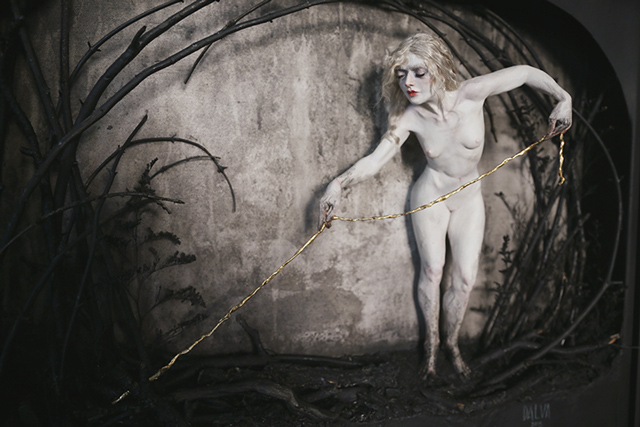
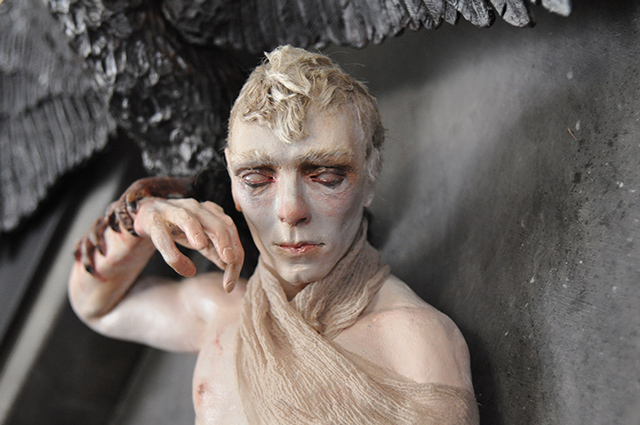



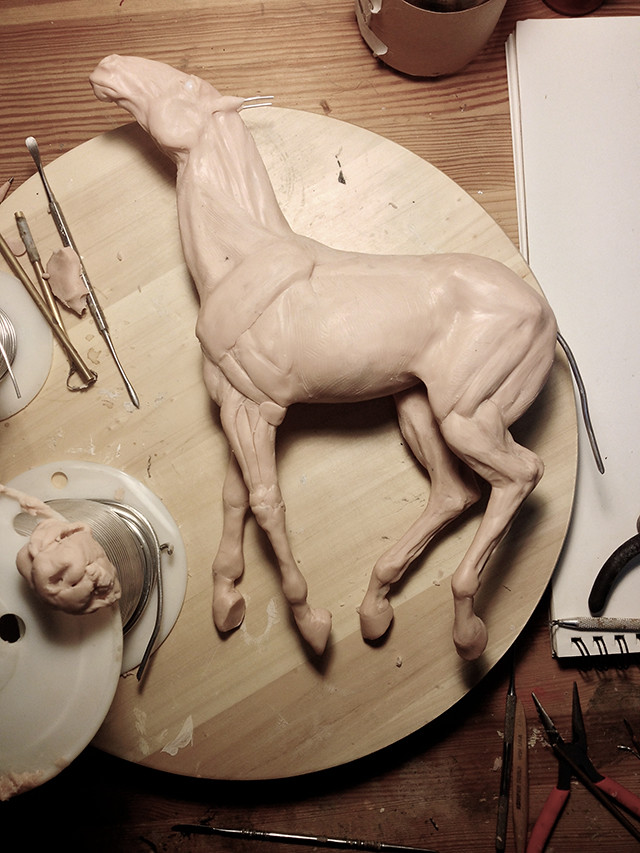

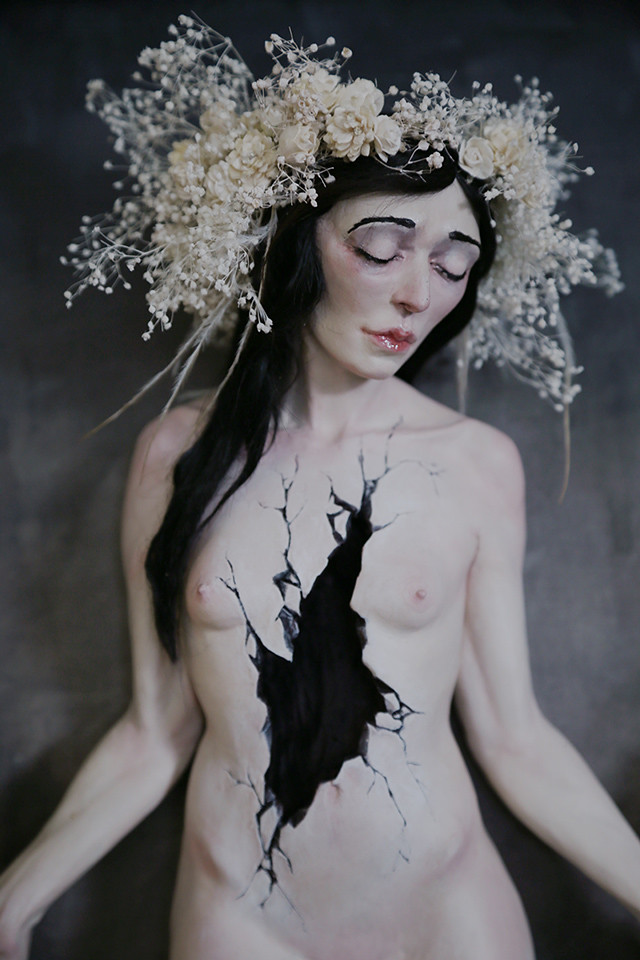

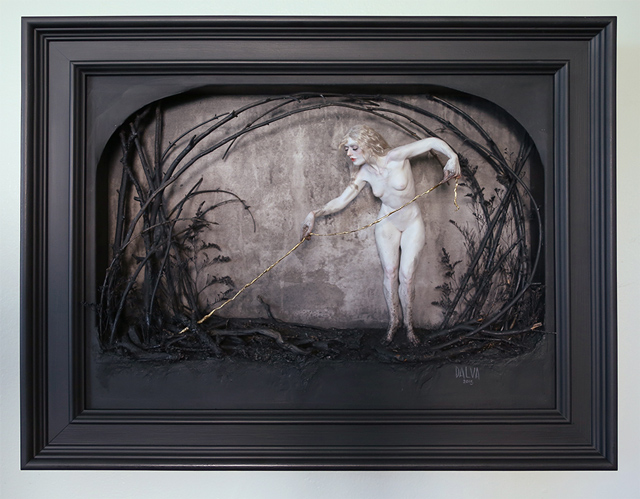



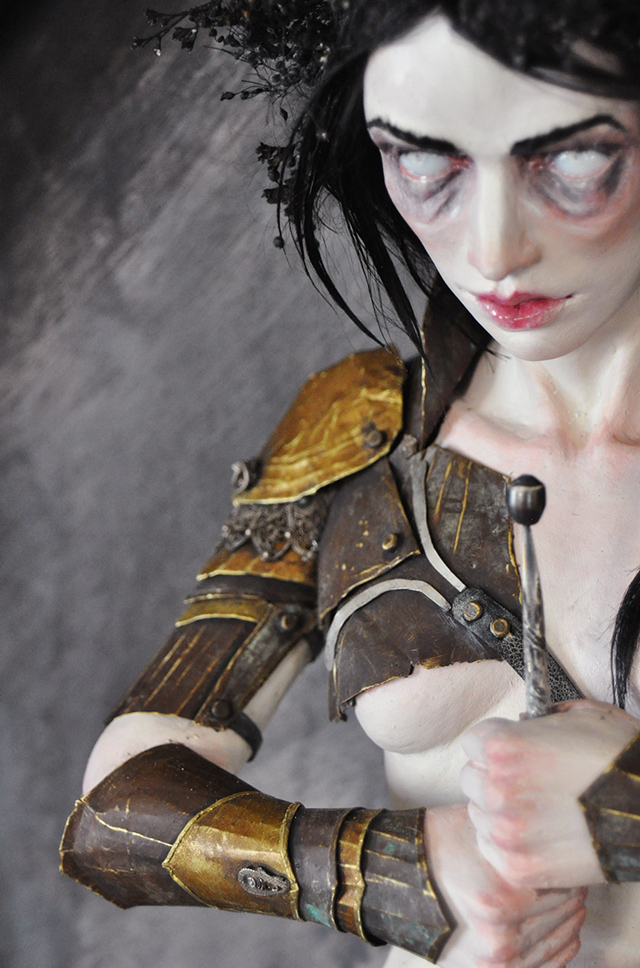
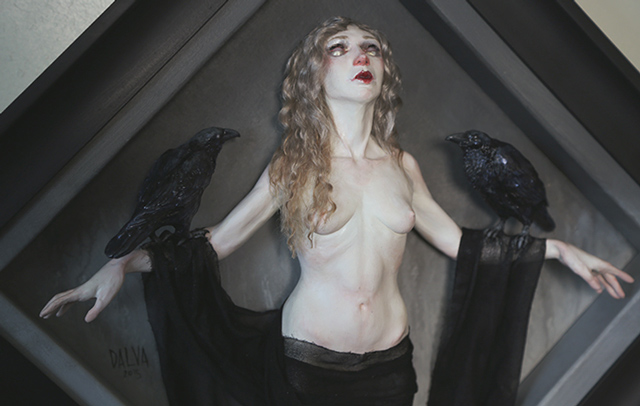
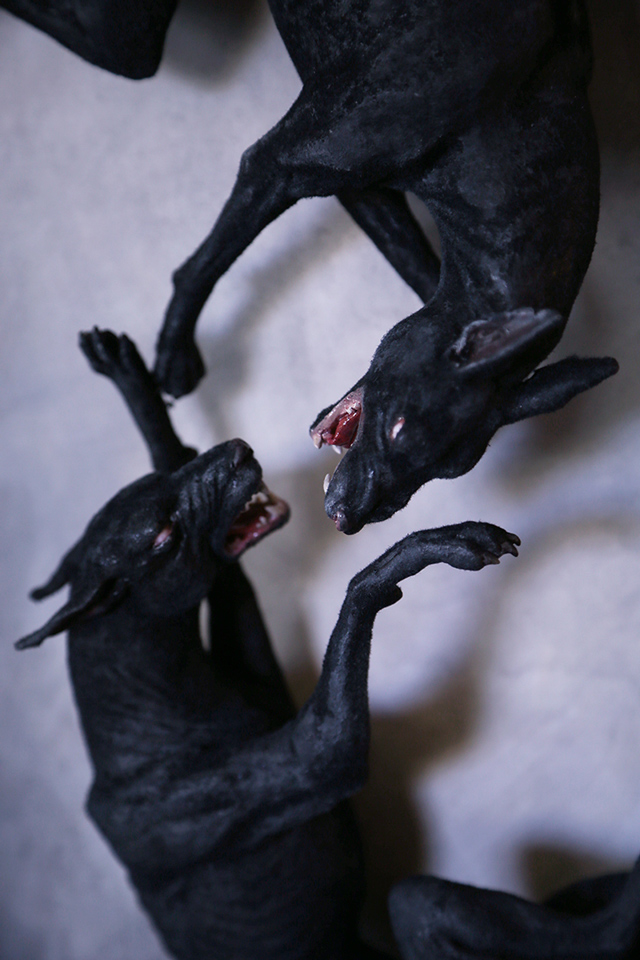
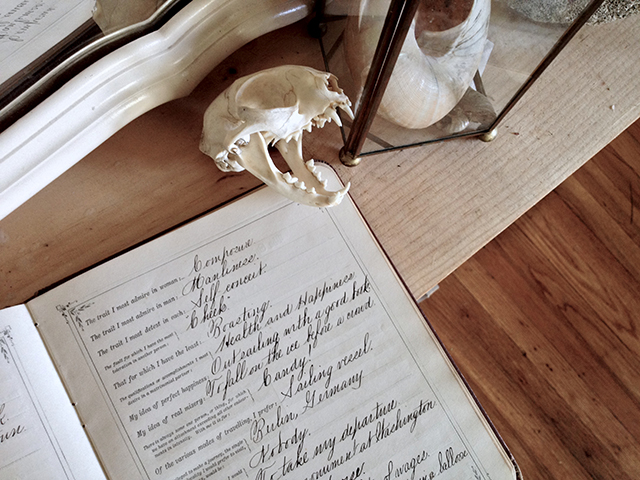
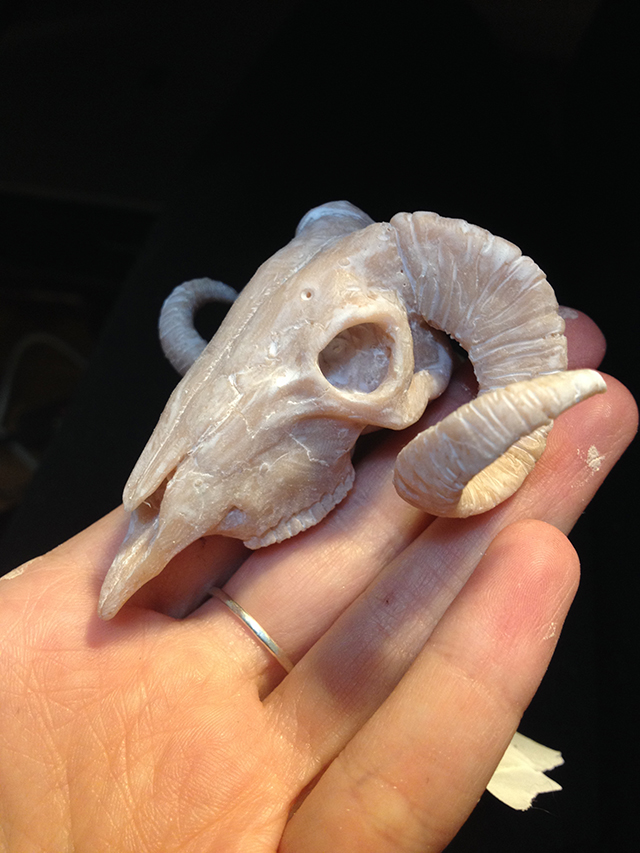
2 comments :
Wow! Those sculptures are simply amazing! beautiful work!
Mesmerizing- the interview and the art. Cheers!
Post a Comment